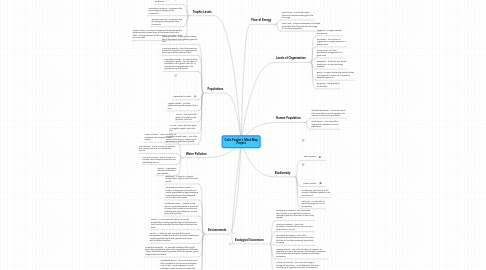Colin Fowler's Mind Map Project
by Colin Fowler

1. Populations
1.1. Limiting Factors - These are the reasons why a population cannot simply grow for ever.
1.2. Carrying Capacity - This is the maximum amount of organisms of a single species that a given evironment can hold.
1.3. Population Growth - The rate at which a population grows. For example, if a population has a growth rate of 2, it means that every generation, the population size will double.
1.4. Exponential Growth -
1.5. Logistic Growth - This like exponential growth except it has a limit.
1.6. J-curve - This is what the graph of an exponential equation looks like.
1.7. S-curve - This is what the graph of a logistic growth rate looks like.
1.8. Population Growth Rate - This is the amount of young per organism per generation in population growth.
2. Trophic Levels
2.1. Producer - Organisms that produce energy using sunlight.
2.2. Primary Consumer - Organisms tht get energy by eating producers.
2.3. Secondary Consumer - Organisms that get energy by eating primary consumers.
2.4. Tertiary Consumer - Organisms that get energy by eating secondary consumers.
2.5. Trophic Leves - The levels of organisms that separate the producers and various levels of consumers from each other. Only ten percent of the energy in one level moves on to the next.
3. Environments
3.1. Rainforest - A forest in a tropical climate with a large amount of annual rainfall.
3.2. Temparate Deciduous Forest - A forest in a temparate climate that is usually populated by large deciduous trees with effective seed dispersal, such as oaks and maples.
3.3. Coniferous Forest - A forest, usually found in cooler temperate or sub-arctic climates, that consists of conifers with relatively poor seed dispersal, such as pines and hemlocks.
3.4. Desert - An arid area with little or no annual precipitation, usually populated by hardy shrubs and cacti, as well as animals that can derive moisture from food.
3.5. Tundra - A relatively arid area with little annual precipitation, located in sub-arctic or arctic climates and usually populated by shrubs, grasses, and hardy, well-insulated creatures.
3.6. Grassland/Savannah - An area with relatively little rainfall, generally populated by short and long grasses and little else. Some animals that would populate it include coyotes, prairie dogs, snakes and hawks.
3.7. Freshwater Biome - This is an environment that is located in and around a freshwater river or lake. Some organisms include planktons, insect larvae and insects, fish, mussels, and water plants.
3.8. Marine Biome - This is an environment that is located in and over an ocean. Some organisms would include fish, planctions, whales, and seabirds.
4. Ecological Succession
4.1. Ecological Succession - The process by which plants in an area that is barren or damaged grow and the order in which they appear.
4.2. Primary Succession - This is the succession process that occurs on an area where there is no soil.
4.3. Secondary Succession - This is the succession process that occurs on and area that has soil and was previously populated by plants.
4.4. Pioneer Species - This is the first type of organism to populate an area in the process on ecological succession - lichens in primary succession, weeds in secondary succession.
4.5. Climax Community - This is the final stage in ecological succession. If not disturbed, this is the community of organisms that will last almost for eternity.
5. Water Pollution
5.1. Water Pollution - This is the entry of pollutants into the Earth's water supply.
5.2. Point Source - This is a source of pollution that can be traced to an indentifiable source.
5.3. Non-Point Source - This is a source of pollution that cannot be traced to and identifiably source.
5.4. Aquifer - A geological formation that stores groundwater.
6. Levels of Organization
6.1. Organism - a single member of a species
6.2. Population - the number of organisms in a single species in a specific area
6.3. Community - All of the populations of organisms in a given area
6.4. Ecosystem - the biotic and abiotic elements in an area functining together
6.5. Biome - a region defined by abiotic factors that supports a certain set fo specially adapted organisms
6.6. Biosphere - the entirety of life on earth
7. Flow of Energy
7.1. Food Chain - a chart with biotic factors and arrows showing the flow of energy
7.2. Food Web - a large combination of multiple food webs that shows the flow of energy for an entire ecosystem
8. Biodiversity
8.1. Biotic Factors -
8.2. Abiotic Factors -
8.3. Biodiversity - Biodiversity is the amount of different species in an environment.
8.4. Hot Spot - An area with an especially large amount of biodiversity.
9. Human Population
9.1. Industrial Revolution - This is the event that caused the enormous growth rate increase in the human population.
9.2. Black Plague - This caused the largest ever decrease in human population.


